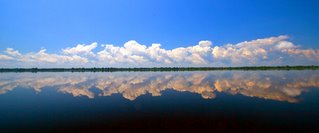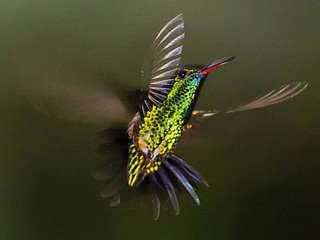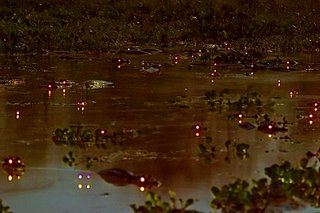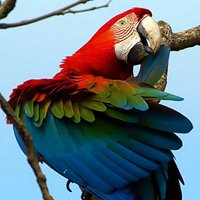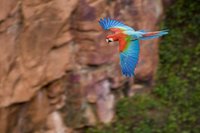22 December, 2006
18 December, 2006
"On Cloud Nine"
Have a look at this year’s last Gallery in Fotograma, with nice pictures of clouds. In case we don’t meet here again in 2006, I wish you Merry Christmas and a great transition for 2007, hoping that the new year brings us all more and more opportunities for great pictures and pleasant situations amidst nature!
15 December, 2006
National Geographic Hummingbirds article coming out!
"Breaking News": it has just been confirmed that the article about hummingbirds in the National Geographic Magazine, for which I worked together with photographer Luis Mazariegos in Dec’05, will be in the January 2007 issue (click for details).
I wouldn’t want to miss that!
.
.
11 December, 2006
Birds and Photography in 2006:
The Top Ten list
The Top Ten list
.
.
... And there goes 2006. Based on the idea of my good colleague and friend Guto Carvalho, author of Passarinhar blog, I decided to come up with a personal list describing the 10 most remarkable situations related to birds through which I have gone in this nearly-finished year!
Here we go (the list doesn’t follow any order of priority or preference):
1) Accompanying and photographing an active nest of Ornate Hawk Eagles (Spizaetus ornatus) with a chick at Maracaju Mountain Range, with a privileged view.

.
.
2) Accompanying and photographing an active nest of Harpy Eagles (Harpia harpyja) on the borders of Serra da Bodoquena National Park, with a privileged view.

.
.
3) Watching and photographing a pair of Mallards (Anas platyrhynchos) with their backs covered by snow, in Germany (some folks told me that this is a quite rare scene to watch since the birds keep on diving to remove the snow before it builds up).

.
.
4) Being invited to set up exhibitions with some of my bird photos in Munich and at Avistar 2006 – I Brazilian Birdwatching Meeting.

.
.
5) To be with Tietta when she concluded her Master’s dissertation about
"Birdwatching Tourism".

.
.
6) Being invited to write and provide pictures for the cover story of Atualidades Ornitológicas # 133, Brazil’s leading periodical publication about birds.
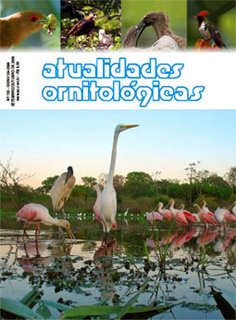
.
.
7) To see the birdwatching market growing bigger and bigger in Brazil, be it by means of an increase in the interest of people and the media, or by the “boom” of printed and virtual publications about the subject.

© Daniel De Granville, 2004-2005
.
.
8) Visiting Cristalino Jungle Lodge and its incredible birdwatching tower over the canopy.

.
.
9) Being able to spend a total of about six weeks this year in the middle of the Pantanal (on duty, but right by the birds!).

.
.
10) Being able to watch a pair of Plumbeous Kites (Ictinia plumbea) everyday near my house – they seem to be nesting some dozen yards away from my front door (despite the fact that many trees around have been stupidly chopped down a few days ago).

.
.
I hope that 2007 brings us all
more and more incredible situations in close contact with nature!
.
.
.
08 December, 2006
Pantanal: From Dawn 'till Dusk
Picture yourself getting up at 3:30 AM, taking a quick gulp of black coffee and leaving – still in the dark – on an army-style 4WD truck built in the 1940’s. The destination? A place that you still don’t know if it’s reachable. When will you come back? Theoretically tonight, but…
Therefore, bring along everything that might be necessary: besides the “regular” working tools (in my case all of the photo paraphernalia), remember the spare car battery, the jack, chain, flashlight, wooden boards (might help in case we get stuck), shovel, food, hammocks, mosquito nets, clothes, water, walkie-talkie, fuel, tarp.
A nightmare? A sacrifice? Not at all, it’s just another sensational shooting day in the Pantanal! This story was written while I was based at Fazenda Rio Negro, on a photo assignment for the Conservation International, where I was photographing some of the region’s Private Reserves of the Natural Heritage for a catalog. This was the last trip, when I took photos of the places that still lacked good images.
Yes, it’s a lot of work, the days are long, it’s tiring and requires a lot of good humor plus adventurous spirit. But it provides indescribable moments, which make me feel privileged. First, because the landscapes and scenes and animals that I have the chance of seeing are just sensational. Second, because the people who I end up having contact with in order to do my job are as cool as the place! Spending hours away from any sign of civilization, having lunch at the edge of a lagoon with the sounds of birds and admiring the landscape – all of this brings me a lot of good sensations. Even if on the way back our car gets stuck and I get eaten by mosquitoes while helping my buddy out...
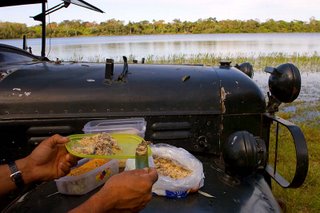
Lunch time. No spoon? No problem! Just improvise one
using the leaf of a bromeliad.
PHOTO: © Daniel De Granville, 2006
* It’s worth explaining that such things will happen solely on special working occasions. Whoever intends to visit the Pantanal on a leisure trip will sure receive the same hospitable treatment which is one of the region’s highlights, but at the same time will find much more comfort to visit these places with safety and tranquility.
01 December, 2006
Working for the National Geographic, Part 3: Hummingbirds
To celebrate the first anniversary of this assignment, let’s go on with today’s post!
After working on the Pantanal story, in December 2005 I was hired again by the National Geographic Society. This time I spent two weeks on the field as a producer, photo assistant and guide for Colombian photographer Luis Mazariegos, who is working on an upcoming story about hummingbirds. Mazariegos, author of the highly praised book "Hummingbirds of Colombia", has been a specialist on hummingbird photography for over 25 years, and is considered as the photographer who has the vastest image collection of these birds in the world.
We traveled long distances in search of very specific objectives, such as the Hooded Visorbearer Augastes lumachella, a species who is confined to an extremely restrict area in the region of the Chapada Diamantina (Bahia State, Brazil). We went from São Paulo to Ubatuba, then Itatiaia, Minas Gerais, Bahia, Rio de Janeiro and Espírito Santo, always searching for hummingbirds. I was impressed with Mazariegos’ expertise and awareness when taking care of these birds, about which he is a great specialist – and not just on the photographic aspect. For this reason, even though photography is not his main professional activity, the Nat Geo chose him to take the photos for the article.
Ultimately, despite the intense working rhythm, I even had time to take my own photos, some of which illustrate this post. Hummingbirds are always very hard to photograph due to their quickness and the iridescence of their feathers, but when you get a good image all efforts are worth it.
28 November, 2006
Working for the National Geographic, Part 2
.
.
( Read Part 1 of this story)
.
.
.
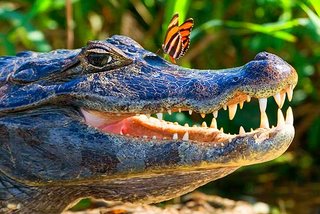 The guy who did all the damage probably looks pretty much like this… PHOTO: © Daniel De Granville, 2006
The guy who did all the damage probably looks pretty much like this… PHOTO: © Daniel De Granville, 2006Following on with the stories about my trips with the Nat Geo, there’s a nice one about the day when we did the photo which was chosen to open the article in the magazine (an underwater shot of a caiman with fish around).
This is how it worked: I had to stand up in a rapid which was crowded with caimans (reeeeally crowded!), with water waist high, holding the underwater camera with the help of a handle which we adapted from a painters’ pole. Joel Sartore would stay on the outside, about 30 feet away, watching the whole scene through a monitor and remotely firing the camera whenever he saw the opportunity for a good shot. I had to follow his instructions: “go closer”, “lower”, “horizon is crooked”, “try to get the caiman in profile”, “tilt up”, and so on. All of this was done with the equipment about 10 inches away from the critters’ mouths, since we were using a 24 mm wide angle lens.
It took us three full days to get “ The Shot”, the one in which the photographer clicks and feels sure that it was worth all efforts. And, in our case, the efforts included the most peculiar moment of the whole story: I was fully at ease, doing my job, when I felt a sort of a thud on the camera’s pole. I thought it was a rock coming down with the current, but just to make sure I decided to check it out. I took the camera out and noticed that the underwater housing’s glass dome had some water inside. I called Joel, we analyzed the equipment and noticed some scratches plus three holes through the dome, the result of a bite that some caiman in a bad mood decided to take at our gear. Luckily I took the camera out of the water in time, before it got wet, and the glass didn’t shatter, which could have caused some wound in our crocodilian buddy (even though I am not sure if some smithereens of glass would do any harm to folks who are used to crushing live piranhas...).
.
.
21 November, 2006
Once More, The Pantanal...
.
.
 A cousin of the dude above was the one who almost bit off
A cousin of the dude above was the one who almost bit offa chunk of my toe last Sunday...
PHOTO © Daniel De Granville, 2006
The full week without any posts in FotogramaBits was due to a couple of short trips that I’ve taken through the Pantanal lately. One of them was particularly outstanding, as I was guiding British photographer Mark Hannaford, who is also the founding director of Across the Divide, a UK-based charity and corporate challenge company.
Besides a piranha bite in my toe, during these trips I got some nice shots which can be checked out in my website's Month Gallery (Nov.2006). Enjoy!
.
.
13 November, 2006
Creatures of the Night
A neat challenge for wildlife photographers is to get good images of nocturnal animals. Among the difficulties, I emphasize the inherent search for critters in the dark, the need to provide supplementary light in order to make the photos and the quest for a framing or background which adds creativeness to the image.
In the Pantanal, there is a popular tourism activity called “spotlighting”, in which visitors go on roads or rivers at night with strong light beams. It is by far the best way to find animals such as foxes, ocelots, owls, nightjars, caimans and many others. Besides helping on the search, the light can be useful to help on framing, focusing and lighting up the subject.
 Long-tongued bat (Phyllostomidae/Glossophaginae) making use
Long-tongued bat (Phyllostomidae/Glossophaginae) making useof a hummingbird feeder at the Atlantic Forest
PHOTO © Daniel De Granville, 2005
Speaking of light, using a flash (which I assume as a “necessary evil”) will be almost always mandatory, unless the animal is very close, the light beam is very good, your lens has a wide aperture and the ISO is at its highest settings.
A more creative image can be obtained by “playing around” with shutter speed to make use of the ambient light, or using some of the flash’s special features, or by using peculiar techniques such as “light painting”. It is important to highlight that, since these photos show critters who are less known by the general public (since they are nocturnal), this kind of photography might delight the observer more easily than a daytime shot.
Last, but just as important: the seek for animals at night must follow certain criteria to avoid excessive disturbance on them. A strong light source, used persistently during a critical period, can disturb feeding and breeding of a nocturnal animal, or make it more vulnerable to predators. If the animal has diurnal habits and is found at rest, the use of such means shall be strictly avoided.
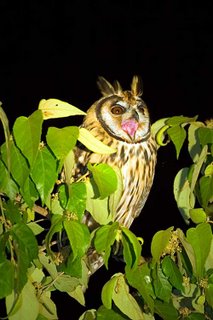 Striped Owl (Rhinoptynx clamator), a species that prefers
Striped Owl (Rhinoptynx clamator), a species that prefersopen areas and whose diet includes vampire bats
PHOTO © Daniel De Granville, 2006
.
.
.
03 November, 2006
Working for the National Geographic, Part I
.
.
 Setting up the camera with a remote trigger
Setting up the camera with a remote triggerby a Jabiru Stork’s nest 60 feet up high!
(photo: Joel Sartore - Joel Sartore Photography)
Three years ago this week, my last field trip with the National Geographic for the Pantanal story, for which I worked in several stages, was getting to an end. Doubtlessly this job became a cornerstone in my professional career and my personal life – that’s when I decided to put photography in first place on my list of priorities.
During some 4 months (besides several weeks spent on pre-production), in 2003, I traveled all over the Pantanal working as a field assistant and guide for photographer Joel Sartore, author of the images that illustrate the article. Those were extremely busy and sometimes tense days, but at the same time (as always) very rewarding. The list of funny and absurd stories might deserve a blog of its own, maybe some day I’ll dedicate myself to it...
It includes from walking in a river full of sting rays, piranhas and caimans to place the remote camera at the best angle, to the unusual strike of an anaconda who missed us by a few inches, when we were in waist-high water. Or the plane in which I had to push a button on the outside of the cabin so that the flaps would work. Or the day when we got stuck with Vavá’s (great driver and friend!) pickup truck late in the afternoon, and after walking a couple of miles in a swamp carrying cases with film rolls and gear, ended up spending the night at a ranch’s stable, lying down on horse blankets that had been intensively used the morning before. Or the time when I had to be hauled into town by plane due to a mysterious health problem, which not even the doctor was able to diagnose – at the end it was just a botfly’s maggot in my scalp...
We also had the “swamp cam” (a fancy name that we chose just to impress people, according to Sartore), probably one of the best stories: it was placed in the middle of the swamp, about an inch above the water surface. One morning a catfish got tangled in the camouflaged cloth that involved the equipment, and a wood stork came after it. The bird kept on persistently pulling the cloth until the camera sunk in the mud, while we watched the whole scene through the remote wireless monitor, 100 yards away. What followed was surreal. We were in the middle of the Pantanal, with our feet in the same water where the “swamp cam” had dived, using our satellite phone to call the Nat Geo technicians in the US and ask what we should do: “Shall we let the film dry or keep it wet?”. “Can it be recovered? Shall we ship them to you right away or try to get it processed immediately at the nearest photo lab?”. “The camera is not a problem, we have many others, but this roll of film has some killer shots!”. Since no one knew the exact answer, the solution was easy: call Fuji Japan directly and ask! The answer was that we had to keep the film moist and ship it to the USA ASAP, so that we had to set up a real rescue operation, rushing to Cuiabá (the nearest capital) in time to find FedEx’s office open.
Next Episode (coming soon): "The Day When a Caiman Bit a Hole Through our Underwater Housing's Glass Dome"
OR
Read More: parts of the story and some photos in Portuguese, English, Spanish, Italian, Japanese, Dutch, Turkish or Hungarian!
 Joel Sartore and Daniel De Granville leaving for
Joel Sartore and Daniel De Granville leaving foranother hard working day in the Pantanal
(photo: Andre Thuronyi - Araras Eco Lodge)
.
.
.
21 October, 2006
"The Right Place"
My wife Tietta found this text on a book that she read some time ago, when accomplishing her Masters’ degree. She found that it had “a lot to do with nature photography”, read it aloud to me and I decided to share it with Fotograma Bits’ readers.
Indeed, its author Edward O. Wilson (one of the world’s most outstanding living naturalists) was able to express a lot of what I feel when out in the field photographing. He talks about persistence, patience, attention, concentration, creativeness and even a bit of luck – virtually everything that I consider necessary when “hunting” for a good nature photography. I hope you enjoy your reading!
"The Right Place"
The naturalist is a civilized hunter. He goes alone into a field or woodland and closes his mind to everything but that time and place, so that life around him presses in on all the senses and small details grow in significance. He begins the scanning search for which cognition was engineered. His mind becomes unfocused, it focuses on everything, no longer directed toward any ordinary task or social pleasantry. He measures the antic darting of midges in a conical mating swarm, the slant of sunlight by which they are best seen, the precise molding of mosses and lichens on the tree trunk on which they spasmodically alight. His eye travels up the trunk to the first branch and out to a spray of twigs and leaves and back, searching for some irregularity of shape or movement of a few millimeters that might betray an animal in hiding. He listens for any sound that breaks the lengthy spells of silence. From time to time he translates his running impressions of the smell of soil and vegetation into rational thought: the ancient olfactory brain speaks to the modern cortex. The hunter-in-naturalist knows that he does not know what is going to happen. He is required, as Ortega y Gasset expressed it, to prepare an attention of a different and superior kind, “an attention that does not consist in riveting itself to the presumed but consists precisely in not presuming anything and avoiding inattentiveness”.
Edward O. Wilson, in “Biophilia, The human bond with other species” (p. 103).
13 October, 2006
Hit the Road, Jack!
This week I will be out in the Pantanal guiding a group of Dutch ecotourists – therefore, FotogramaBits will get no updates for awhile...
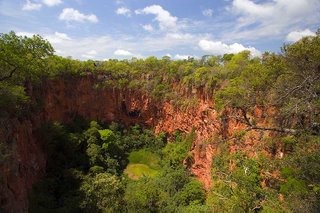
In the meantime, I hope you enjoy some of the pictures that I took today at the must-see Buraco das Araras, one of the largest sinkholes in the Americas, which is about 37 miles away from my home.
See you soon!
09 October, 2006
Macgyvering Photo Gear
Before you ask, the title of this article comes from the 1980’s TV character MacGyver, who was very inventive and could fix a space shuttle’s engine using a rubber band and a broken toothpick. The Brazilian word which could better describe the act of macgyvering things is “gambiarra”. By what I have searched and asked, there is no real or official equivalent of “gambiarra” in English – maybe “improvising” could be it, but the concept behind that specific term goes beyond this.
All of the above is just an introduction to today’s subject: photo equipment is extremely expensive and sometimes very hard to find in Brazil, as well as in other countries. If you want some specific device you must import it, which means an extra 70% (at least) in taxes. In other words, a photographer buying any equipment in Brazil will pay about twice the average US street price.
Considering the average income down here, usually the only viable solution for us is the famous DIY (do-it-yourself) approach – in other words, being creative. I have been doing a lot of this for nature recording equipment, one of my hobbies during my spare time, and now I am planning to work on a new remote shooting device to capture images similar to the one which illustrates this article (and is the cover for this month’s issue of Brazil’s main publication about birds).
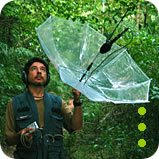
PHOTO © Tietta Pivatto, 2005
During my assignments with the National Geographic as a field assistant (posts about this coming soon!), every now and then we created things with what we had in the middle of nowhere, so in those moments my macgyvering (or “gambiarra, if you prefer) skills were extremely helpful! I guess this is very much what nature photography is about.
.
.
06 October, 2006
Death on the Road
.
.
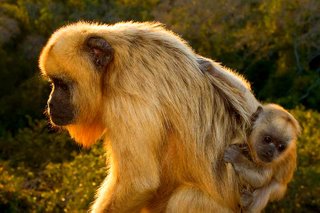 Female Black Howler (Alouatta caraya) with its young
Female Black Howler (Alouatta caraya) with its young near the Transpantaneira Road
PHOTO © Daniel De Granville, 2003
This week, more precisely on October 4th, we celebrate the World Animal Day, which – not by chance – overlaps the day of St. Francis of Assisi, considered as the Patron of Animals.
For a long time I’ve been thinking about setting up an itinerant exhibition on this date, with photos and information, aimed to bring up drivers’ awareness about the problem of wildlife kills in our roads – specially those which cross more preserved natural environments, such as the Pantanal. Since 1999 I have systematically collected photo records of animal road kills, and unfortunately it has not been a difficult task to find the subjects I must photograph.
While the exhibition doesn’t come true, this subject gradually brought up the media’s interest, and in August 2005 I was invited by the National Geographic to publish an article about the theme on their website, simultaneously with the Pantanal story that came out in the same edition.
The main inspiration for my work came from the research carried out between 1996 and 1997 by Brazilian biologist Wagner Fisher, where he registered the death of 1,400 animals in one year of studies along the Federal Road 262, that crosses the South Pantanal. Among the victims are 88 species – many of which endangered – including caimans, capybara, foxes, anteaters, armadillos, several birds (such as hawks and seriemas) and even jaguars.
This subject is food for thought during your next road trip, since animals might not be the only victims of such accidents.
05 October, 2006
About the Joys and Distresses
of a Nature Photographer
of a Nature Photographer
.
.

Serra da Bodoquena National Park, Bonito, Brazil
PHOTO: © Daniel De Granville, 2006
Biology became part of my professional life prior to photography, but my connections with nature come from much longer ago, since I was a kid and didn’t even have to think about a career. I still remember my mom’s reaction on the day she went into my bedroom and found the walls covered with hairy caterpillars, which I had brought home in a shoebox and wanted to “care for ‘till they turned into butterflies”.
Due to this strong bond with wildlife since my childhood, associating these two activities – photography plus biology – and making a profession out of them has been, more than a planned objective, a natural tendency. To know animals both in theory and with hands on, and to like them a lot, is crucial to get the images that I’m looking for.
But despite all of the glamour associated with nature photography, it is not an easy career. One day you find yourself waking up extremely early in places such as the Pantanal, having to walk in the dark through swamps full of caimans and surrounded by clouds of mosquitoes, before the rising of a sun that will soon make temperatures go over 100 oF. Next week you might be freezing your ears and fingers on the edge of a cliff, at the top of some mountain in the Bavarian Alps, waiting for the best light. Not only you suffer, but also does the photo gear, which is extremely expensive and delicate. A minor failure and all of your work may be lost… This keeps me constantly tense when I’m out in the field, until the photos are finally saved into my computer, printed on paper or delivered to the client.
The photos which illustrate this text, for example, took a total of over 40 hours of “stand by” under adverse and risky conditions, in exchange for a few good shooting moments – maybe no more than 5 minutes…
At the same time, however, it is an incredibly gratifying life. Each time that I spend hours observing scenes that very few people in our planet will ever have a chance of seeing, such as a rare species of hawk bringing prey to feed its young at the first morning light, I feel privileged and realized.
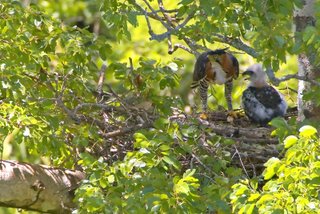
Photo: © Daniel De Granville, 2006
People will frequently ask me if I’m not afraid of spending hours or days alone in remote areas full of animals and other “perils of nature”. Maybe I really should be more careful about certain risks, but whenever I’m photographing in a natural area I feel totally integrated with everything that surrounds me. Moreover, I must concentrate a lot in order to do my job, and here such worries which could disturb me simply don’t fit in.
To me, the most important of all in this job, besides persistence, patience, concern with minimum details and a restless personality, is to adopt an ethical attitude towards natural environments. Firstly, I never accept to cause an excessive disturbance in a certain place just to get the image that I want. Second, I always feel obliged to reward nature for every good thing that it has provided me with until today.
Showing my photos is one of the means that I have to reach this objective. If people become thrilled upon seeing these images and raise their awareness and admiration about nature, I consider that my mission is accomplished.
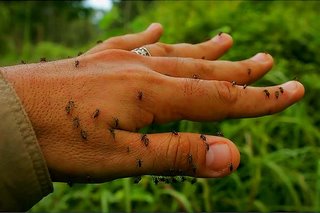
PHOTO: © Daniel De Granville, 2006
.
.
04 October, 2006
Finally Online!
.
.
Scouting for Jaguars while on assignment in the Pantanal of Brazil...
(Photo: © M. Juelsgaard, 2006)
Hello to all,
Some time ago I felt the need of making my website more dynamic. The first initiative in this direction was taken at the end of 2005, when I upgraded the site contents and layout – but it still seemed not enough.
By mid June this year, after returning from my sponsored period in Germany, I came up with the Portuguese version of this blog, which now gets an English edition – at last!
My intention is to keep an “up close and personal” contact with visitors and friends, telling behind the scenes stories and talking about other less formal subjects (but never losing focus on photography and environment). And, of course, always showing recent images that I have been making while on the field, be it on a regular outdoor ride or on a serious assignment.
Some of the posts will be the same for both versions and others will be exclusive, depending on the subject. I plan to gradually translate the former contents from the original Portuguese edition into English too.
Be welcome and thanks for visiting!
... and the result of this very lucky day!
(Photo: © Daniel De Granville, 2006)
.
.


